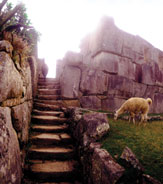Warm
Water, Cold Water
Tracing El Niño to the Shores of Peru
R.J. Gangewere
 Curator
James Richardson at Machu Picchu. Curator
James Richardson at Machu Picchu.
James
A. Richardson III, curator of Anthropology at Carnegie
Museum of Natural History, has been digging in the
sands of ancient seashores nearly all his life. Born
in Massachusetts, his family has a house on Martha’s
Vineyard, where as a child he would play on the beaches,
and later as an archaeologist he would dig up evidence
of the early inhabitants who lived on the island. But
what he will most likely be remembered for in the
world of maritime archaeology took him far from the
Vineyard. In the 1980s, Richardson discovered that
the ancient people of the shores of Peru some 5,000
years ago left behind evidence that today reveals
a
lot about El Niño, the periodic storms that
bring disaster to the western coast of South America
and the islands of the Pacific Ocean.
For thousands
of years El Niño was absent and
therefore not a factor in cultural change along
the Peruvian coast. But after ca. 6,000 B.P. (Before
the Present), the sea level rose to near current
levels
and the modern coastline was formed. At this time
the cold Peru (Humbold) current shifted northward
from
12 degrees south latitude to 4.3 degrees south
latitude.
The colder Peruvian current brought with it the
ocean fish and molluscan riches that soon formed
the basis
for the rise of the temple societies along the
Peruvian coast.
The 200-meter depth contour typically
defines the
outer edge of the continental shelf.
The shoreline
11,000 years ago was just inside
the current 100-meter
contour.
 Still,
the warm ocean current returned at irregular
intervals as El Niño, a counter-current.
The warm waters of El Niño bring death
to plankton and fish and cause severe storms
in the
Pacific and
on the South American coast. The storms were
called “the
Christ Child” (El Niño) because
they came with the onset of warm weather before
Christmastime
in the Southern Hemisphere. Still,
the warm ocean current returned at irregular
intervals as El Niño, a counter-current.
The warm waters of El Niño bring death
to plankton and fish and cause severe storms
in the
Pacific and
on the South American coast. The storms were
called “the
Christ Child” (El Niño) because
they came with the onset of warm weather before
Christmastime
in the Southern Hemisphere.
Richardson’s
research has traced back for thousands of years
evidence of the people who
lived along the
changing seacoast. Their ancient debris of cooking
shellfish, fish, birds, and sea mammals, testifies
to the rising of the sea levels, which were 400
feet lower 25,000 years ago. Although many ancient
inhabited
sites along the level seashore are now underwater,
in those places where the seacoast is narrow
(because the continental shelf is short between
the mountains
and the deep ocean), the evidence of ancient
human habitation can still be examined. In 1986,
Richardson and his colleague Daniel
Sandweiss of the University of Maine proposed
that the record
of warmwater shellfish at northern Peruvian
coastal sites led to the conclusion that El Niño
did not begin or originate until after 5,800
years ago.
Many oceanographers, geologists, and paleo-climate
specialists disagreed, believing that El Niño
could not be so recent a weather phenomenon.
But in trying to prove the Richardson-Sandweiss
theory wrong,
they actually proved it was correct. They demonstrated
that El Niño did not occur in the past
with the frequency that it has today. There
was a 3,000-
to 4,000-year period of colder waters along
the coast that corresponded to the rise of
the Peruvian
temple
cultures.
The theory about El Nino’s
relationship to the first Peruvian cultures
was featured in the premier
issue of Discovering Archaeology (January,
February, 1999). Richardson’s South American
research was published in his book People of
the Andes. (Smithsonian
Books, 1994) n
Back to Contents
Learn More About Machu
Picchu
 Free with museum admission! Free with museum admission!
Machu Picchu Lecture Series
Co-sponsored by the University of Pittsburgh, Center
for Latin American Studies, and Carnegie Museum
of Natural History.
October 18, 2003, 1 p.m.
Machu Picchu--Dr. Richard Burger, Yale Peabody Museum,
Co-Curator of Machu Picchu: Unveiling the Mystery
of the Incas.
October 18, 11:30 a.m.
In the Lecture Hall—a musical performance by
Musuhallpa. Hear the music of the Andean mountain regions
of Peru, Bolivia, Ecuador, Chile, and Argentina.
Other free lectures on Machu Picchu are scheduled
for November 15 and December 6. See the November/ December
issue for details.
Enjoy a Lecture, the Exhibit, and a Peruvian Foods
Buffet at the Museum
November 8, 2003, 10:30 a.m.
CMA Theater
Join Carnegie Museum of Natural History Curator Dr.
James B. Richardson III in an exploration of the Andean
people and their incredible city in the clouds.
Lecture, Buffet, & Museum Admission:
Members, Students, Seniors: $23
Non-members: $25
Lecture & Museum Admission only (no Buffet):
Members,
Students, Seniors: $8 Non-members: $10
Back to Contents |